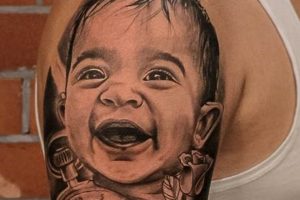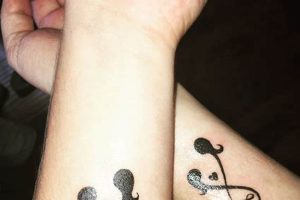Tattoos representing familial bonds are a popular choice. Designs incorporating symbolism for a mother, daughter, and son often involve interconnected imagery or matching elements that represent their shared history and affection. Examples include intertwined Celtic knots, a trio of birds, or three interlocking circles. Stylistic choices range from minimalist line art to elaborate watercolor or illustrative pieces.
These permanent expressions of familial love can serve as a constant reminder of the unbreakable bond between family members. They offer a tangible and highly personal way to commemorate shared experiences, honor family heritage, or celebrate a significant milestone. Historically, body art has been used across cultures to mark familial ties and social status, demonstrating the enduring human impulse to visually represent these connections.
Key considerations for these types of tattoos include choosing meaningful symbols, selecting an appropriate placement on the body, and finding a skilled tattoo artist who can execute the design effectively. Exploring different artistic styles and discussing design options with family members ensures a collaborative and satisfying outcome, resulting in a treasured piece of body art that resonates with everyone involved.
Tips for Family Tattoos
Careful planning ensures a meaningful and aesthetically pleasing family tattoo. Consider these tips before committing to a design.
Tip 1: Collaborative Design: Open communication is crucial. Each family member should contribute ideas and express preferences regarding symbolism, style, and placement.
Tip 2: Meaningful Symbolism: Choose imagery that resonates with the entire family. Consider shared hobbies, inside jokes, meaningful quotes, or symbols representing shared values.
Tip 3: Cohesive Style: While individual elements can differ, maintaining a consistent style across all tattoos creates a unified and harmonious look. This could involve matching line weights, color palettes, or artistic styles.
Tip 4: Placement Considerations: Discuss desired placement with each family member and the tattoo artist. Consider visibility, pain tolerance, and how the design might flow with the body’s contours.
Tip 5: Research and Choose a Skilled Artist: Thorough research is essential. Look for artists specializing in the desired style and review their portfolios. Consultations with potential artists are recommended.
Tip 6: Size and Detail: Consider the overall size and level of detail desired. Intricate designs might require larger areas, while simpler designs can be effective in smaller placements. Factor in potential changes to the body over time.
Tip 7: Think Long-Term: Tattoos are permanent. Ensure the chosen design and symbolism hold enduring significance for all involved.
By following these tips, families can create meaningful tattoos that celebrate their bond and serve as lasting reminders of their shared connection.
These considerations pave the way for a positive and fulfilling experience, resulting in cherished artwork that holds deep personal significance for each family member.
Shared symbolism forms the foundation of meaningful mother, daughter, and son tattoos. Selecting imagery that resonates with each individual strengthens the familial bond and imbues the tattoos with lasting significance. This shared meaning transforms the artwork into more than just a design; it becomes a visual representation of their interconnectedness.
- Representational Imagery
Objects or animals can hold shared meaning, representing inside jokes, shared passions, or family history. For instance, a trio of butterflies could represent transformation and growth, while three mountains might symbolize resilience and strength. These tangible symbols provide a visual anchor for shared experiences and values.
- Abstract Designs
Celtic knots, interlocking circles, or infinity symbols represent the eternal and unbreakable bond between family members. Abstract designs offer a timeless quality, transcending specific events and focusing on the enduring nature of familial love. These symbols often carry deeper cultural or historical meanings, adding another layer of significance.
- Meaningful Quotes or Script
A short quote or phrase meaningful to the family can be incorporated into the tattoo design. This could be a line from a favorite poem, song lyrics, or a family motto. The chosen script itself can also carry significance, reflecting shared heritage or personal style. The visual representation of shared words further strengthens the connection.
- Birth Flowers, Birthstones, or Significant Dates
Incorporating birth flowers, birthstones, or significant dates adds a personal touch to the shared symbolism. These elements represent individual identities within the larger family unit, acknowledging both shared history and individual uniqueness. These personal details ground the symbolism in specific family milestones and create a truly unique design.
Ultimately, the chosen symbolism should reflect the unique dynamic and shared history of the mother, daughter, and son. By carefully selecting meaningful imagery, the tattoos become a powerful expression of their enduring connection, a visual testament to their shared journey and unbreakable bond. This shared visual language serves as a constant reminder of their love and interconnectedness.
2. Cohesive Style
Cohesive style plays a vital role in the overall aesthetic and impact of mother, daughter, and son tattoos. Visual harmony achieved through consistent artistic choices strengthens the sense of unity and familial connection represented in the designs. While individual elements might differ, maintaining a cohesive style ensures the tattoos complement each other, creating a unified and harmonious visual narrative.
- Matching or Complementary Color Palettes
Using the same or complementary colors across all three tattoos creates a sense of visual cohesion. This could involve using the same dominant color with variations in shades or incorporating complementary colors that harmonize well together. For example, if one tattoo features shades of blue, the others could incorporate complementary oranges or analogous greens. This creates a visual link between the tattoos, even if the designs themselves are different.
- Consistent Line Weight and Style
Maintaining a consistent line weight and style is crucial for visual harmony. Whether the designs feature bold lines, fine lines, or a combination, consistency creates a sense of balance and unity. This could involve using similar line thicknesses across all tattoos or employing the same line style, such as solid, dotted, or dashed lines. Consistent linework creates a subtle yet powerful connection between the individual pieces.
- Unified Artistic Style
Choosing a single artistic style, such as watercolor, realism, or tribal, provides a unifying aesthetic. While individual design elements can vary within the chosen style, the overall artistic approach remains consistent. For example, if one tattoo features a watercolor rendering of a flower, the others could incorporate watercolor elements in different ways, such as splashes of color or a watercolor background. This maintains a cohesive artistic language across all tattoos.
- Incorporating Shared Design Elements
While each tattoo can have its own unique design, incorporating shared elements creates a visual connection. This could involve using a repeating motif, such as a specific flower, symbol, or geometric shape, across all three tattoos. These shared elements serve as visual threads, tying the individual pieces together and reinforcing the sense of familial connection. They provide a subtle yet powerful reminder of the shared bond.
A cohesive style ensures that the individual tattoos, while potentially distinct in design, work together as a unified whole. This visual harmony amplifies the message of familial connection and creates a powerful and aesthetically pleasing representation of the bond between a mother, daughter, and son. The cohesive style elevates the individual tattoos, transforming them into a collective statement of familial love and unity.
3. Appropriate Placement
Placement is a crucial aspect of mother, daughter, and son tattoos, impacting visibility, symbolism, and personal significance. Careful consideration of placement ensures the tattoos complement individual preferences and body contours, enhancing both aesthetic appeal and personal meaning. Appropriate placement transforms the tattoos into a harmonious extension of the individuals, reflecting their unique personalities and shared bond.
- Visibility and Discretion
Visibility preferences vary. Some families prefer easily visible placements, showcasing their bond openly, while others opt for more discreet locations, reserving the symbolism for personal reflection. A visible placement, such as the forearm or wrist, allows for easy sharing and serves as a constant visual reminder of the family connection. A more discreet placement, such as the back or ribcage, offers privacy and allows the tattoos to serve as a more intimate expression of the familial bond.
- Body Contours and Design Flow
The human body’s natural curves and contours should be considered. Certain designs lend themselves well to specific placements, enhancing the tattoo’s aesthetic impact. A flowing design might be particularly striking along the spine or collarbone, while a smaller, more compact design might be better suited for the wrist or ankle. Careful consideration of body contours ensures the design flows naturally and complements the individual’s form.
- Symbolic Significance of Placement
Placement can add another layer of symbolism. For instance, a tattoo placed near the heart can represent deep emotional connection, while a tattoo on the shoulder might symbolize support and strength. These symbolic placements further enhance the meaning of the tattoos, transforming them into a powerful and personalized expression of familial love.
- Practical Considerations and Pain Tolerance
Certain areas are more sensitive than others. Individual pain tolerance and lifestyle factors, such as profession or clothing choices, should be considered when choosing placement. Areas with thinner skin or closer proximity to bone tend to be more sensitive. Considering practical factors, such as potential exposure to sunlight or friction from clothing, ensures the longevity and aesthetic appeal of the tattoos.
Appropriate placement enhances the personal significance and aesthetic impact of mother, daughter, and son tattoos. By considering visibility, body contours, symbolic meaning, and practical factors, families can ensure their chosen designs become a beautiful and meaningful expression of their enduring bond, reflecting their shared history and individual preferences. This thoughtful approach to placement elevates the tattoos beyond mere body art, transforming them into a powerful and personalized statement of familial love and unity.
4. Skilled Artist Selection
Selecting a skilled tattoo artist is paramount for realizing the full potential of mother, daughter, and son tattoo ideas. A skilled artist translates meaningful concepts into beautiful and enduring artwork, ensuring the chosen designs reflect the family’s unique bond. The artist’s expertise significantly impacts the final result, affecting not only the aesthetic quality but also the longevity and safety of the tattoos. Choosing the right artist is an investment in a permanent piece of art that represents a significant familial connection.
- Artistic Style and Specialization
Different artists specialize in various styles, ranging from minimalist linework to intricate realism or vibrant watercolor. Aligning the chosen design with an artist’s specialization ensures the final product meets expectations. For example, a family seeking delicate floral tattoos would benefit from an artist specializing in fine line botanical work, while those desiring a realistic portrait would seek an artist specializing in portraiture. Matching artistic style to the desired aesthetic is crucial for achieving the desired outcome.
- Portfolio and Experience
A comprehensive portfolio showcases an artist’s skill level and consistency. Reviewing previous work provides insight into their technical abilities, artistic style, and experience with similar designs. A portfolio demonstrating a consistent track record of high-quality work instills confidence and provides a tangible representation of the artist’s capabilities. Examining healed tattoos within the portfolio also offers valuable insight into the long-term quality of the artist’s work.
- Hygiene and Safety Practices
Adherence to strict hygiene and safety protocols is non-negotiable. A reputable artist prioritizes client safety by using sterilized equipment, following proper aftercare procedures, and maintaining a clean and sanitary work environment. Thorough sterilization practices, adherence to health regulations, and the use of single-use needles are essential for minimizing health risks. Prioritizing safety ensures a positive and healthy tattooing experience.
- Communication and Collaboration
Open communication and a collaborative approach are essential for achieving desired results. A skilled artist actively listens to client preferences, offers professional guidance, and ensures a clear understanding of the design vision. Effective communication ensures the final design accurately reflects the family’s shared vision. A collaborative relationship between the artist and the family fosters trust and facilitates a smooth and satisfying tattooing process.
Selecting a skilled artist transforms mother, daughter, and son tattoo ideas into cherished works of art. By carefully considering artistic style, experience, safety practices, and communication, families can ensure their chosen designs are executed with precision and artistry, resulting in tattoos that beautifully and enduringly symbolize their unique bond. A skilled artist’s expertise elevates the entire experience, transforming a meaningful concept into a tangible and lasting representation of familial love.
5. Long-Term Considerations
Permanence distinguishes tattoos from other forms of artistic expression. Therefore, long-term considerations are paramount when choosing mother, daughter, and son tattoo designs. Changes in familial relationships, evolving personal aesthetics, and the body’s natural aging process can impact the perceived significance of a tattoo over time. A design chosen impulsively might later become a source of regret, while a carefully considered design can retain its meaning and beauty for decades. For instance, incorporating names directly into the tattoo design can become problematic if relationships shift. Opting for symbolic representations of the bond rather than specific names offers more resilience to potential changes in family dynamics.
The body’s natural aging process also necessitates careful design choices. Intricate details and fine lines might blur or lose definition as skin loses elasticity. Bold lines and simpler designs generally age better, retaining their visual impact over time. Placement is also crucial. Areas prone to significant changes due to weight fluctuations or aging, such as the abdomen or lower back, might distort the tattoo design. Choosing a placement less susceptible to these changes, such as the forearm, wrist, or ankle, helps preserve the design’s integrity.
Ultimately, considering the long-term implications of a tattoo ensures a design remains meaningful and aesthetically pleasing throughout life’s various stages. Choosing timeless symbolism, considering the body’s natural aging process, and avoiding overly personalized elements like names enhances the longevity of the tattoo’s significance. This thoughtful approach ensures the chosen design remains a cherished representation of familial love, a testament to an enduring bond that transcends time and change. Consultation with a skilled tattoo artist is crucial in this process, as their expertise can guide design choices that prioritize long-term satisfaction and minimize potential regrets.
Frequently Asked Questions
This section addresses common questions regarding mother, daughter, and son tattoos, offering practical insights and guidance for those considering this type of familial body art.
Question 1: What are some symbolic representations suitable for mother, daughter, and son tattoos?
Suitable symbols include interconnected elements like Celtic knots, the trinity knot, or a tree with three branches. Representational imagery, such as three birds or butterflies, can also symbolize the family unit. Meaningful quotes or phrases relevant to family bonds offer another avenue for symbolic representation. Birth flowers, birthstones, or Roman numerals representing significant dates add a personal touch.
Question 2: How can one ensure design cohesion across three separate tattoos?
Cohesion is achieved through consistent artistic choices. Utilizing a unified color palette, similar line weights and styles, and a consistent artistic approach, such as watercolor or realism, create visual harmony. Incorporating shared design elements, like a repeating motif or a consistent background element, further ties the individual tattoos together.
Question 3: What factors should influence placement choices for these tattoos?
Placement should consider visibility preferences, body contours, and symbolic significance. Areas like the forearm or wrist offer high visibility, while the back or ribcage provides more discretion. The design should complement the body’s natural curves. Symbolic meaning can also influence placement, such as placing the tattoo near the heart to represent emotional connection.
Question 4: What is the typical cost range for these types of tattoos?
Costs vary based on design complexity, size, artist experience, and geographic location. Small, simple designs might range from a few hundred dollars, while larger, more intricate pieces can cost significantly more. Consulting with several artists allows for comparison of pricing and artistic styles.
Question 5: How can one find a reputable and skilled tattoo artist?
Thorough research is essential. Reviewing online portfolios, seeking recommendations from friends or family, and consulting with multiple artists are recommended. A reputable artist maintains a clean and sterile work environment, adheres to safety protocols, and possesses a strong portfolio showcasing consistent high-quality work.
Question 6: What aftercare practices are crucial for ensuring proper healing and longevity of the tattoos?
Proper aftercare involves keeping the tattoo clean and moisturized, avoiding excessive sun exposure, and refraining from picking or scratching the tattooed area. Following the artist’s specific aftercare instructions is crucial for proper healing and maintaining the tattoo’s vibrancy over time. Consulting a dermatologist if any complications arise is recommended.
Careful consideration of these frequently asked questions equips individuals with the necessary knowledge to make informed decisions regarding mother, daughter, and son tattoos, ensuring a positive and fulfilling experience resulting in cherished artwork.
Further research into specific design elements and artistic styles is encouraged to create truly personalized and meaningful familial tattoos.
Conclusion
Tattoos symbolizing the bond between a mother, daughter, and son represent a powerful expression of familial love. Careful consideration of shared symbolism, cohesive style, appropriate placement, and skilled artist selection ensures these permanent expressions of affection resonate with each individual and stand the test of time. Thoughtful planning and open communication throughout the design process are crucial for a positive and fulfilling experience. Exploring various artistic styles and symbolic representations allows families to create deeply personal and meaningful artwork that celebrates their unique connection.
These permanent markings serve as a lasting testament to familial love, a visual reminder of the unbreakable bond shared between a mother, daughter, and son. The enduring nature of these tattoos reflects the timeless significance of family connections, offering a powerful and poignant celebration of kinship.







